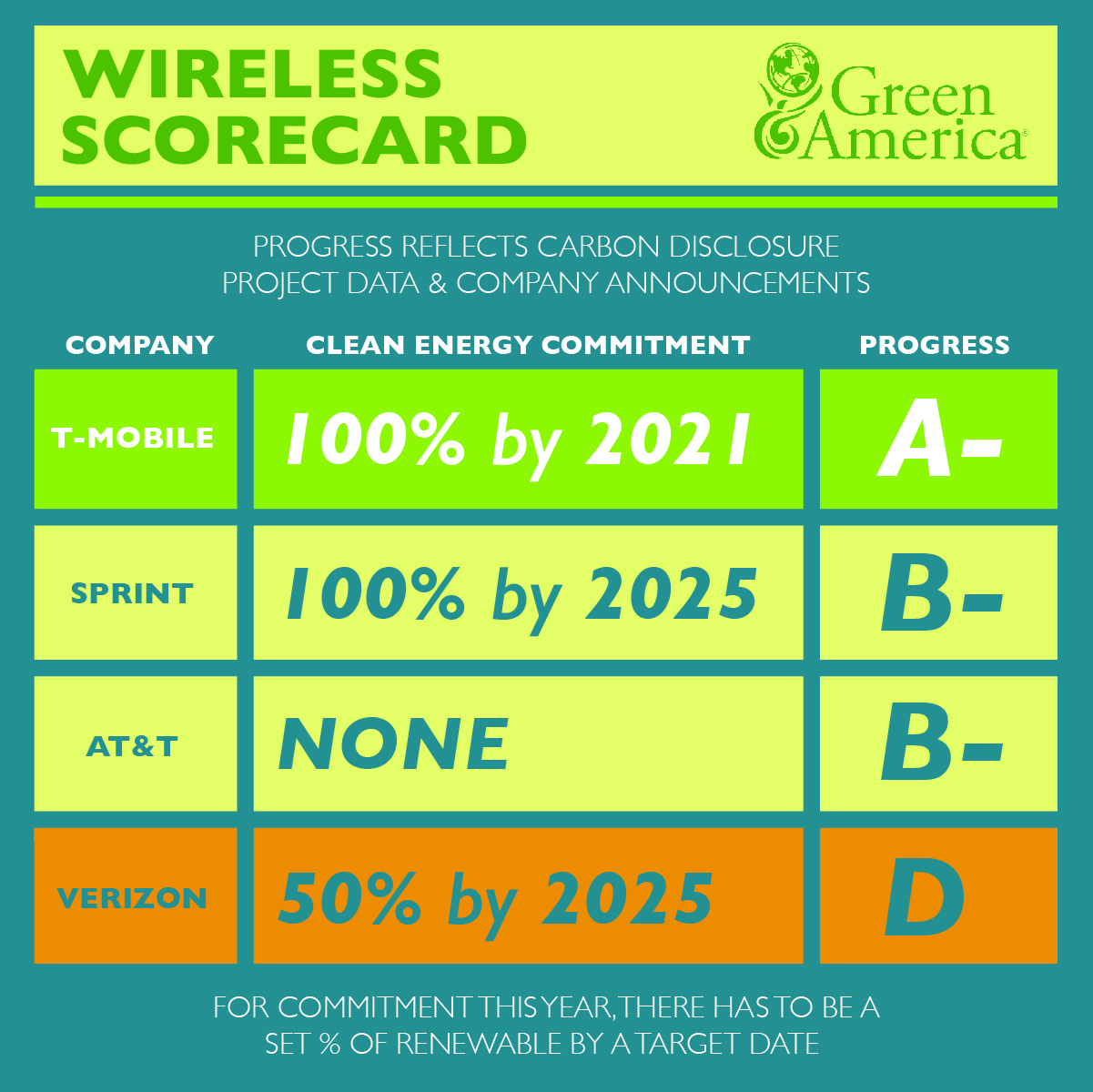
Report Grades AT&T, Sprint, T-Mobile and Verizon on Renewable Energy Sourcing and Commitments; New Sections Detail Diversity Issues in Industry and COVID-19’s Impact on Findings.
WASHINGTON – June 16, 2020 – Verizon is back at the bottom of Green America’s Clean Energy Wireless Scorecard that grades the top U.S. telecommunications companies on their renewable energy usage, with only 3-5 percent estimated clean energy use. Verizon previously ranked above Sprint, which has raced to the number two spot after being the industry laggard.
According to Green America’s updated “Clean Energy is Calling” report, T-Mobile continues to lead the industry through its commitment to reach 100 percent renewables by 2021. Second-place Sprint announced a goal of 100 percent clean energy by 2025 and its first renewables project to provide 30 percent of its total energy use. With T-Mobile merging with Sprint, T-Mobile has committed to release an updated timeline to move both T-Mobile and Sprint to 100 percent renewables. In third place, AT&T has acquired over 1.5 gigawatts of renewables since 2018, an estimated quarter of its total use. However, AT&T is now the only telecom without a public target or timeline on clean energy. In February 2020, last-place Verizon announced a new wind energy project as its first move to use part of its $1 billion green bond to reach 50 percent renewables by 2025. But its current clean energy contracts will only result in an estimated 3-5 percent renewable energy

“Consumers have a clear choice between telecoms when it comes to clean energy, with T-Mobile (now merged with Sprint) still in the lead,” said Todd Larsen, executive co-director of Green America. “While AT&T and Verizon have made important first steps towards powering their networks with 100 percent renewable energy, they still have a long way to go to get to the 100 percent needed to protect people and the planet.”
While the telecom sector already uses enormous amounts of energy – the four largest companies collectively use more than 3 million MWh of electricity each year – the new report discusses the impact of COVID-19, including significant increases in usage since March likely to result in an uptick in energy consumption, which could outweigh the gains of energy efficiency in the networks. The report also includes a new section on social responsibility of clean energy firms and how telecom companies can influence improvements in diversity and equity in the renewables sector.
At a time when the clean energy sector in the U.S. has lost over 500,000 jobs due to COVID-19, increased purchasing of renewables by the telecom sector could also help to re-employ thousands of people in renewable energy. And, the four largest telecommunications companies can use their massive clean energy purchases to encourage the solar and wind sectors to increase their diversity. Currently, women and African Americans are underrepresented in solar and wind jobs.
When Green America launched its “Hang Up on Fossil Fuels” campaign in 2017, the sector used less than 2 percent renewables with hardly any significant commitments in place to increase. Now, Green America estimates that if all current commitments are met, approximately 45 percent of the four companies’ networks overall will be powered by clean energy. AT&T followed by Verizon use the most energy so if they move to 100 percent renewable energy, it will bring the sector much closer to 100 percent renewable energy.
“Ever since people across the country began calling on telecoms to shift to renewable energy, we’ve seen significant changes throughout the industry,” said Beth Porter, climate campaigns director at Green America. “But there’s still more work to be done to reach 100 percent clean energy by 2025 and our campaign will continue to urge for progress and hold these companies accountable to their commitments.”
Each of the companies is graded on current commitments and actual clean energy being used. This is based on direct responses from companies to Green America’s Clean Energy Calling questionnaire and publicly available data through company announcements and the Carbon Disclosure Project, which reflects 2018 energy use.
MEDIA CONTACT: Max Karlin for Green America, (703) 276-3255, or mkarlin@hastingsgroup.com.



